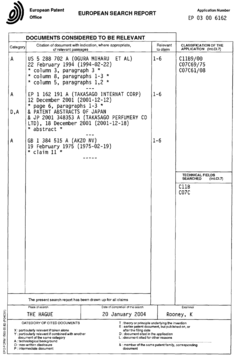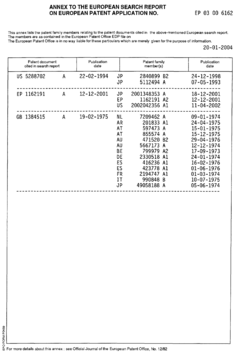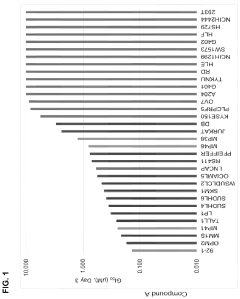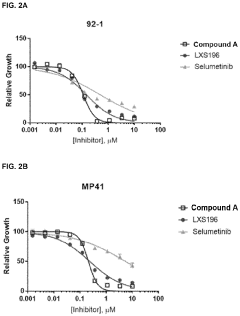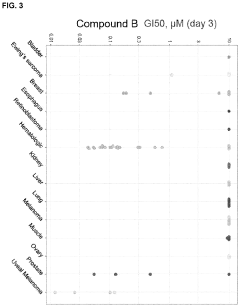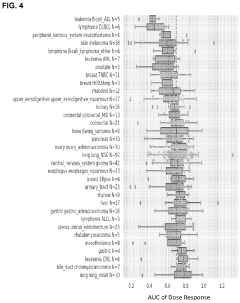Analysis of Geometric Isomers in Cosmetic Chemistry
AUG 1, 20259 MIN READ
Generate Your Research Report Instantly with AI Agent
Patsnap Eureka helps you evaluate technical feasibility & market potential.
Geometric Isomers in Cosmetics: Background and Objectives
Geometric isomers have played a significant role in the evolution of cosmetic chemistry, shaping the development of various products and formulations. The study of these molecular structures has been crucial in understanding the behavior and efficacy of cosmetic ingredients. Over the past few decades, the cosmetics industry has witnessed a growing interest in leveraging the unique properties of geometric isomers to enhance product performance and safety.
The historical trajectory of geometric isomer research in cosmetics can be traced back to the mid-20th century when scientists began to recognize the importance of molecular structure in determining the properties of cosmetic ingredients. This realization led to a surge in studies focused on identifying and characterizing geometric isomers in natural and synthetic compounds used in cosmetic formulations.
As analytical techniques advanced, researchers gained deeper insights into the subtle differences between geometric isomers and their impact on cosmetic applications. This progress has been particularly evident in the fields of fragrance chemistry, UV protection, and active ingredient delivery systems. The ability to manipulate and control geometric isomerization has opened up new possibilities for product innovation and efficacy enhancement.
The primary objective of studying geometric isomers in cosmetic chemistry is to optimize the performance and safety of cosmetic products. This involves understanding how different isomeric forms affect properties such as stability, solubility, penetration, and bioavailability. By harnessing this knowledge, formulators can develop more effective and targeted cosmetic solutions that cater to specific consumer needs.
Another key goal is to explore the potential of geometric isomers in addressing emerging challenges in the cosmetics industry. These include the development of sustainable and eco-friendly ingredients, the creation of multifunctional cosmetic compounds, and the enhancement of product shelf life without compromising safety or efficacy.
Furthermore, the analysis of geometric isomers aims to contribute to the broader field of structure-activity relationships in cosmetic science. By establishing correlations between molecular geometry and functional properties, researchers can predict the behavior of novel compounds and streamline the product development process. This approach not only accelerates innovation but also reduces the need for extensive empirical testing, leading to more efficient and cost-effective research and development strategies.
In the context of regulatory compliance and consumer safety, the study of geometric isomers is essential for ensuring the quality and reliability of cosmetic products. Understanding the potential for isomerization under various conditions helps manufacturers maintain product stability and efficacy throughout the supply chain and during consumer use.
The historical trajectory of geometric isomer research in cosmetics can be traced back to the mid-20th century when scientists began to recognize the importance of molecular structure in determining the properties of cosmetic ingredients. This realization led to a surge in studies focused on identifying and characterizing geometric isomers in natural and synthetic compounds used in cosmetic formulations.
As analytical techniques advanced, researchers gained deeper insights into the subtle differences between geometric isomers and their impact on cosmetic applications. This progress has been particularly evident in the fields of fragrance chemistry, UV protection, and active ingredient delivery systems. The ability to manipulate and control geometric isomerization has opened up new possibilities for product innovation and efficacy enhancement.
The primary objective of studying geometric isomers in cosmetic chemistry is to optimize the performance and safety of cosmetic products. This involves understanding how different isomeric forms affect properties such as stability, solubility, penetration, and bioavailability. By harnessing this knowledge, formulators can develop more effective and targeted cosmetic solutions that cater to specific consumer needs.
Another key goal is to explore the potential of geometric isomers in addressing emerging challenges in the cosmetics industry. These include the development of sustainable and eco-friendly ingredients, the creation of multifunctional cosmetic compounds, and the enhancement of product shelf life without compromising safety or efficacy.
Furthermore, the analysis of geometric isomers aims to contribute to the broader field of structure-activity relationships in cosmetic science. By establishing correlations between molecular geometry and functional properties, researchers can predict the behavior of novel compounds and streamline the product development process. This approach not only accelerates innovation but also reduces the need for extensive empirical testing, leading to more efficient and cost-effective research and development strategies.
In the context of regulatory compliance and consumer safety, the study of geometric isomers is essential for ensuring the quality and reliability of cosmetic products. Understanding the potential for isomerization under various conditions helps manufacturers maintain product stability and efficacy throughout the supply chain and during consumer use.
Market Demand for Isomer-based Cosmetic Products
The market demand for isomer-based cosmetic products has been steadily growing in recent years, driven by increasing consumer awareness of the benefits of specific molecular structures in skincare and beauty formulations. Geometric isomers, in particular, have garnered significant attention due to their unique properties and potential to enhance the efficacy of cosmetic products.
One of the primary factors fueling this demand is the rising trend of personalized skincare solutions. Consumers are becoming more educated about the ingredients in their beauty products and are seeking formulations tailored to their specific skin types and concerns. Geometric isomers offer the potential for more targeted and effective treatments, as different isomeric forms can exhibit varying levels of bioavailability and activity on the skin.
The anti-aging segment of the cosmetics market has shown particularly strong interest in isomer-based products. Retinoids, a class of compounds derived from vitamin A, are a prime example of how geometric isomers can impact product efficacy. The all-trans retinoic acid isomer is known for its potent anti-aging effects, while other isomeric forms may offer reduced irritation or enhanced stability. This has led to a surge in demand for products containing carefully controlled isomeric ratios of retinoids.
Sun protection is another area where isomer-based cosmetics are gaining traction. Certain geometric isomers of UV filters have demonstrated superior performance in blocking harmful rays while maintaining a lightweight feel on the skin. This has resulted in increased consumer interest in sunscreens and daily moisturizers that incorporate these advanced isomeric formulations.
The natural and organic cosmetics sector has also embraced isomer-based ingredients, particularly those derived from plant sources. Essential oils and botanical extracts often contain complex mixtures of geometric isomers, each contributing to the overall fragrance and therapeutic properties of the product. As consumers gravitate towards natural solutions, the demand for cosmetics that harness the power of these naturally occurring isomeric blends has grown significantly.
Market research indicates that the global isomer-based cosmetics market is expected to experience robust growth over the next decade. This growth is anticipated to be driven not only by established markets in North America and Europe but also by emerging markets in Asia-Pacific, where consumers are increasingly sophisticated in their beauty product choices and willing to invest in advanced formulations.
However, challenges remain in fully realizing the market potential of isomer-based cosmetics. These include the need for improved manufacturing processes to ensure consistent isomeric ratios, regulatory considerations regarding the safety and efficacy of specific isomers, and the requirement for clear communication to educate consumers about the benefits of these advanced formulations. Despite these challenges, the overall market trajectory for isomer-based cosmetic products remains highly positive, with ample opportunities for innovation and growth in the coming years.
One of the primary factors fueling this demand is the rising trend of personalized skincare solutions. Consumers are becoming more educated about the ingredients in their beauty products and are seeking formulations tailored to their specific skin types and concerns. Geometric isomers offer the potential for more targeted and effective treatments, as different isomeric forms can exhibit varying levels of bioavailability and activity on the skin.
The anti-aging segment of the cosmetics market has shown particularly strong interest in isomer-based products. Retinoids, a class of compounds derived from vitamin A, are a prime example of how geometric isomers can impact product efficacy. The all-trans retinoic acid isomer is known for its potent anti-aging effects, while other isomeric forms may offer reduced irritation or enhanced stability. This has led to a surge in demand for products containing carefully controlled isomeric ratios of retinoids.
Sun protection is another area where isomer-based cosmetics are gaining traction. Certain geometric isomers of UV filters have demonstrated superior performance in blocking harmful rays while maintaining a lightweight feel on the skin. This has resulted in increased consumer interest in sunscreens and daily moisturizers that incorporate these advanced isomeric formulations.
The natural and organic cosmetics sector has also embraced isomer-based ingredients, particularly those derived from plant sources. Essential oils and botanical extracts often contain complex mixtures of geometric isomers, each contributing to the overall fragrance and therapeutic properties of the product. As consumers gravitate towards natural solutions, the demand for cosmetics that harness the power of these naturally occurring isomeric blends has grown significantly.
Market research indicates that the global isomer-based cosmetics market is expected to experience robust growth over the next decade. This growth is anticipated to be driven not only by established markets in North America and Europe but also by emerging markets in Asia-Pacific, where consumers are increasingly sophisticated in their beauty product choices and willing to invest in advanced formulations.
However, challenges remain in fully realizing the market potential of isomer-based cosmetics. These include the need for improved manufacturing processes to ensure consistent isomeric ratios, regulatory considerations regarding the safety and efficacy of specific isomers, and the requirement for clear communication to educate consumers about the benefits of these advanced formulations. Despite these challenges, the overall market trajectory for isomer-based cosmetic products remains highly positive, with ample opportunities for innovation and growth in the coming years.
Current Challenges in Geometric Isomer Analysis
The analysis of geometric isomers in cosmetic chemistry faces several significant challenges that hinder accurate identification and quantification. One of the primary obstacles is the structural similarity between geometric isomers, which makes their separation and detection particularly difficult. Traditional analytical methods often struggle to distinguish between these closely related compounds, leading to potential misidentification or incomplete characterization of cosmetic formulations.
Another major challenge lies in the complexity of cosmetic matrices. Cosmetic products typically contain a wide array of ingredients, including emollients, preservatives, fragrances, and active compounds. This complex mixture can interfere with the detection and analysis of geometric isomers, masking their presence or altering their chemical properties. The diverse range of cosmetic formulations further complicates the development of standardized analytical protocols.
The stability of geometric isomers during analysis poses an additional challenge. Some isomers may undergo interconversion or degradation during sample preparation or analysis, leading to inaccurate results. This is particularly problematic for thermally sensitive compounds or those susceptible to light-induced isomerization. Ensuring the preservation of the original isomeric composition throughout the analytical process remains a significant hurdle.
Furthermore, the lack of comprehensive reference standards for all possible geometric isomers in cosmetic ingredients hampers accurate identification and quantification. Many cosmetic compounds can exist in multiple isomeric forms, and not all of these forms may be commercially available as pure standards. This limitation affects the reliability of analytical methods and the interpretation of results.
The sensitivity and selectivity of current analytical techniques also present challenges. While advanced chromatographic and spectroscopic methods have improved detection capabilities, achieving the required sensitivity for trace-level analysis of geometric isomers in complex cosmetic formulations remains challenging. This is particularly true for products where isomers may be present at very low concentrations but still have significant biological or regulatory implications.
Regulatory requirements add another layer of complexity to the analysis of geometric isomers in cosmetics. Different regions may have varying standards and thresholds for isomeric purity or composition, necessitating the development of analytical methods that can meet diverse regulatory needs. The evolving nature of cosmetic regulations also requires continuous adaptation and validation of analytical approaches.
Lastly, the time and cost associated with comprehensive isomer analysis present practical challenges for routine quality control in the cosmetic industry. High-resolution techniques capable of distinguishing subtle structural differences often require sophisticated instrumentation and expertise, which may not be readily available or economically feasible for all manufacturers or testing laboratories.
Another major challenge lies in the complexity of cosmetic matrices. Cosmetic products typically contain a wide array of ingredients, including emollients, preservatives, fragrances, and active compounds. This complex mixture can interfere with the detection and analysis of geometric isomers, masking their presence or altering their chemical properties. The diverse range of cosmetic formulations further complicates the development of standardized analytical protocols.
The stability of geometric isomers during analysis poses an additional challenge. Some isomers may undergo interconversion or degradation during sample preparation or analysis, leading to inaccurate results. This is particularly problematic for thermally sensitive compounds or those susceptible to light-induced isomerization. Ensuring the preservation of the original isomeric composition throughout the analytical process remains a significant hurdle.
Furthermore, the lack of comprehensive reference standards for all possible geometric isomers in cosmetic ingredients hampers accurate identification and quantification. Many cosmetic compounds can exist in multiple isomeric forms, and not all of these forms may be commercially available as pure standards. This limitation affects the reliability of analytical methods and the interpretation of results.
The sensitivity and selectivity of current analytical techniques also present challenges. While advanced chromatographic and spectroscopic methods have improved detection capabilities, achieving the required sensitivity for trace-level analysis of geometric isomers in complex cosmetic formulations remains challenging. This is particularly true for products where isomers may be present at very low concentrations but still have significant biological or regulatory implications.
Regulatory requirements add another layer of complexity to the analysis of geometric isomers in cosmetics. Different regions may have varying standards and thresholds for isomeric purity or composition, necessitating the development of analytical methods that can meet diverse regulatory needs. The evolving nature of cosmetic regulations also requires continuous adaptation and validation of analytical approaches.
Lastly, the time and cost associated with comprehensive isomer analysis present practical challenges for routine quality control in the cosmetic industry. High-resolution techniques capable of distinguishing subtle structural differences often require sophisticated instrumentation and expertise, which may not be readily available or economically feasible for all manufacturers or testing laboratories.
Existing Methods for Geometric Isomer Analysis
01 Synthesis and separation of geometric isomers
Methods for synthesizing and separating geometric isomers, including techniques for isolating specific isomers from mixtures. This involves various chemical processes and separation techniques to obtain pure geometric isomers for further use or study.- Synthesis and separation of geometric isomers: Methods for synthesizing and separating geometric isomers, including techniques for controlling the formation of specific isomers during chemical reactions and processes for isolating desired isomers from mixtures. These methods may involve catalysts, reaction conditions, or separation techniques such as chromatography.
- Characterization and analysis of geometric isomers: Techniques for identifying and analyzing geometric isomers, including spectroscopic methods, X-ray crystallography, and computational modeling. These approaches help determine the structure, properties, and relative abundance of different isomers in a sample.
- Applications of geometric isomers in pharmaceuticals: Utilization of geometric isomers in drug development and pharmaceutical formulations. This includes studying the biological activity of different isomers, developing methods for producing specific isomeric forms of drugs, and investigating the impact of isomerism on drug efficacy and safety.
- Geometric isomers in materials science and engineering: Exploration of geometric isomers in the development of new materials with specific properties. This includes research on isomeric effects in polymers, liquid crystals, and other advanced materials, as well as applications in fields such as optics and electronics.
- Computational methods for studying geometric isomers: Development and application of computational techniques for predicting, modeling, and visualizing geometric isomers. This includes quantum chemical calculations, molecular dynamics simulations, and machine learning approaches for understanding isomeric structures and properties.
02 Geometric isomers in pharmaceutical compounds
The importance of geometric isomers in pharmaceutical compounds, including their effects on drug efficacy and safety. This involves studying the different biological activities of geometric isomers and developing methods to produce specific isomers for pharmaceutical applications.Expand Specific Solutions03 Analytical methods for geometric isomers
Development of analytical techniques for identifying and characterizing geometric isomers. This includes spectroscopic methods, chromatography, and other analytical tools used to distinguish between different geometric isomers and determine their structures.Expand Specific Solutions04 Geometric isomers in materials science
Applications of geometric isomers in materials science, including their use in developing new materials with specific properties. This involves studying how the arrangement of atoms in geometric isomers affects material characteristics and exploring potential applications in various industries.Expand Specific Solutions05 Computational modeling of geometric isomers
Use of computational methods to study and predict properties of geometric isomers. This includes molecular modeling, quantum chemical calculations, and other computational techniques to understand the behavior and characteristics of geometric isomers.Expand Specific Solutions
Key Players in Cosmetic Isomer Research
The analysis of geometric isomers in cosmetic chemistry is currently in a growth phase, with increasing market size and technological advancements. The global cosmetic chemicals market is expanding rapidly, driven by consumer demand for innovative and effective products. Major players like L'Oréal, BASF, and Novartis are investing heavily in R&D to develop new formulations and improve existing ones. The technology is becoming more sophisticated, with companies like Coatex and Daicel focusing on specialty polymers and chemical-based goods. Emerging players such as Yunnan Botanee and Living Proof are also contributing to the field with novel plant-based extractions and hair care innovations, indicating a diverse and competitive landscape in this sector.
L'Oréal SA
Technical Solution: L'Oréal has developed advanced techniques for analyzing geometric isomers in cosmetic formulations. They utilize high-performance liquid chromatography (HPLC) coupled with mass spectrometry (MS) to separate and identify different isomeric forms of ingredients[1]. This method allows for precise quantification of cis and trans isomers in complex cosmetic matrices. Additionally, L'Oréal employs nuclear magnetic resonance (NMR) spectroscopy to elucidate the three-dimensional structures of isomeric compounds, enabling a deeper understanding of their interactions with skin and hair[2]. The company has also invested in computational modeling to predict the stability and efficacy of different isomeric forms in various cosmetic formulations[3].
Strengths: Cutting-edge analytical techniques, comprehensive approach combining experimental and computational methods. Weaknesses: High cost of equipment and expertise required, potential limitations in analyzing very low concentration isomers.
BASF Corp.
Technical Solution: BASF has developed a multi-faceted approach to analyze geometric isomers in cosmetic chemistry. They employ a combination of chromatographic techniques, including gas chromatography (GC) and supercritical fluid chromatography (SFC), to separate and quantify geometric isomers in complex mixtures[4]. BASF has also pioneered the use of vibrational circular dichroism (VCD) spectroscopy for determining the absolute configuration of chiral molecules and distinguishing between geometric isomers[5]. Furthermore, the company utilizes advanced computational chemistry methods to predict the behavior of geometric isomers in various cosmetic formulations, allowing for more efficient product development[6].
Strengths: Diverse analytical toolkit, strong integration of experimental and computational approaches. Weaknesses: Some techniques may have limited applicability to certain types of cosmetic ingredients.
Innovative Approaches in Isomer Identification
Isomer composition containing optically active ethyl trans-2,2,6-trimethylcyclohexylcarboxylate and fragrance composition containing the isomer composition
PatentInactiveEP1347035A3
Innovation
- A geometrical isomer composition comprising 93 to 99% optically active ethyl trans-2,2,6-trimethylcyclohexylcarboxylate and 7 to 1% optically active ethyl cis-2,2,6-trimethylcyclohexylcarboxylate, which exhibits enhanced chemical resistance and stability, even in alkaline or acidic conditions, preventing deterioration and color change.
Compounds and uses thereof
PatentPendingUS20230145003A1
Innovation
- Development of specific compounds that modulate the BAF complex by inhibiting BRG1 and/or BRM activity, which can be used alone or in combination with other pharmaceutically active agents to treat disorders like cancer.
Regulatory Framework for Isomers in Cosmetics
The regulatory framework for isomers in cosmetics is a complex and evolving landscape that plays a crucial role in ensuring product safety and efficacy. Regulatory bodies worldwide have established guidelines and standards to address the unique challenges posed by geometric isomers in cosmetic formulations.
In the United States, the Food and Drug Administration (FDA) oversees the regulation of cosmetics, including products containing geometric isomers. The FDA's approach is primarily focused on ensuring product safety and proper labeling. While the agency does not require pre-market approval for most cosmetic products, it mandates that manufacturers ensure their products are safe for consumer use and properly labeled.
The European Union (EU) has implemented more stringent regulations through the Cosmetic Products Regulation (EC) No 1223/2009. This regulation specifically addresses the use of isomers in cosmetics, requiring manufacturers to provide detailed information on the chemical composition of their products, including the presence and concentration of geometric isomers. The EU's Scientific Committee on Consumer Safety (SCCS) regularly reviews and assesses the safety of cosmetic ingredients, including isomers, and provides opinions that inform regulatory decisions.
In Japan, the Ministry of Health, Labour and Welfare regulates cosmetics under the Pharmaceutical Affairs Law. The Japanese regulatory framework places a strong emphasis on ingredient safety and requires manufacturers to submit detailed product information, including the presence of geometric isomers, before market approval.
International organizations, such as the International Organization for Standardization (ISO), have developed standards for the analysis and characterization of geometric isomers in cosmetic products. These standards provide harmonized methods for identifying and quantifying isomers, facilitating compliance with regulatory requirements across different jurisdictions.
Regulatory bodies are increasingly focusing on the potential differences in biological activity and safety profiles between geometric isomers. This has led to more specific requirements for isomer characterization and labeling in cosmetic products. Manufacturers are often required to provide detailed information on the isomeric composition of their ingredients and demonstrate the safety of specific isomers used in their formulations.
The regulatory landscape also addresses the potential for isomerization during product storage and use. Manufacturers are expected to conduct stability studies to ensure that the isomeric composition of their products remains consistent throughout the product's shelf life. This requirement aims to maintain product efficacy and safety over time.
As scientific understanding of geometric isomers in cosmetic chemistry continues to advance, regulatory frameworks are likely to evolve. Future regulations may include more specific guidelines on isomer-specific toxicology testing, analytical methods for isomer identification, and labeling requirements to inform consumers about the presence and potential effects of different isomers in cosmetic products.
In the United States, the Food and Drug Administration (FDA) oversees the regulation of cosmetics, including products containing geometric isomers. The FDA's approach is primarily focused on ensuring product safety and proper labeling. While the agency does not require pre-market approval for most cosmetic products, it mandates that manufacturers ensure their products are safe for consumer use and properly labeled.
The European Union (EU) has implemented more stringent regulations through the Cosmetic Products Regulation (EC) No 1223/2009. This regulation specifically addresses the use of isomers in cosmetics, requiring manufacturers to provide detailed information on the chemical composition of their products, including the presence and concentration of geometric isomers. The EU's Scientific Committee on Consumer Safety (SCCS) regularly reviews and assesses the safety of cosmetic ingredients, including isomers, and provides opinions that inform regulatory decisions.
In Japan, the Ministry of Health, Labour and Welfare regulates cosmetics under the Pharmaceutical Affairs Law. The Japanese regulatory framework places a strong emphasis on ingredient safety and requires manufacturers to submit detailed product information, including the presence of geometric isomers, before market approval.
International organizations, such as the International Organization for Standardization (ISO), have developed standards for the analysis and characterization of geometric isomers in cosmetic products. These standards provide harmonized methods for identifying and quantifying isomers, facilitating compliance with regulatory requirements across different jurisdictions.
Regulatory bodies are increasingly focusing on the potential differences in biological activity and safety profiles between geometric isomers. This has led to more specific requirements for isomer characterization and labeling in cosmetic products. Manufacturers are often required to provide detailed information on the isomeric composition of their ingredients and demonstrate the safety of specific isomers used in their formulations.
The regulatory landscape also addresses the potential for isomerization during product storage and use. Manufacturers are expected to conduct stability studies to ensure that the isomeric composition of their products remains consistent throughout the product's shelf life. This requirement aims to maintain product efficacy and safety over time.
As scientific understanding of geometric isomers in cosmetic chemistry continues to advance, regulatory frameworks are likely to evolve. Future regulations may include more specific guidelines on isomer-specific toxicology testing, analytical methods for isomer identification, and labeling requirements to inform consumers about the presence and potential effects of different isomers in cosmetic products.
Safety and Efficacy of Geometric Isomers
The safety and efficacy of geometric isomers in cosmetic chemistry are crucial considerations for both manufacturers and consumers. Geometric isomers, which are molecules with the same molecular formula but different spatial arrangements, can exhibit varying properties that significantly impact their performance and potential risks in cosmetic formulations.
Safety assessments of geometric isomers in cosmetics involve rigorous toxicological studies, including acute and chronic toxicity tests, skin irritation and sensitization evaluations, and mutagenicity screenings. These studies aim to identify any potential adverse effects that may arise from the use of specific isomers in cosmetic products. The results of such assessments often inform regulatory decisions and guide the development of safety guidelines for the cosmetic industry.
Efficacy evaluations of geometric isomers focus on their functional properties and their ability to deliver desired cosmetic benefits. For instance, certain isomers may demonstrate superior moisturizing capabilities, enhanced UV protection, or improved skin penetration compared to their counterparts. These differences can be attributed to the unique spatial arrangements of atoms within the isomeric structures, which influence their interactions with biological systems and other cosmetic ingredients.
In the realm of skincare, the efficacy of geometric isomers is particularly notable in the case of retinoids. All-trans retinoic acid, for example, is known for its potent anti-aging effects, while its geometric isomer, 13-cis retinoic acid, exhibits different biological activities and is used in the treatment of acne. Understanding these isomeric differences allows formulators to optimize the performance of cosmetic products while maintaining safety standards.
The stability of geometric isomers in cosmetic formulations is another critical aspect that impacts both safety and efficacy. Some isomers may undergo interconversion or degradation under certain conditions, such as exposure to light or heat. This can lead to changes in the product's efficacy over time or potentially result in the formation of undesired byproducts. Consequently, stability testing and appropriate packaging solutions are essential to ensure the maintenance of both safety and efficacy throughout the product's shelf life.
Regulatory bodies, such as the FDA and EMA, have established guidelines for the use of specific geometric isomers in cosmetics, taking into account their safety profiles and efficacy data. Compliance with these regulations is paramount for cosmetic manufacturers to ensure consumer safety and product reliability. Additionally, ongoing research continues to explore novel applications of geometric isomers in cosmetics, aiming to enhance product performance while maintaining the highest safety standards.
Safety assessments of geometric isomers in cosmetics involve rigorous toxicological studies, including acute and chronic toxicity tests, skin irritation and sensitization evaluations, and mutagenicity screenings. These studies aim to identify any potential adverse effects that may arise from the use of specific isomers in cosmetic products. The results of such assessments often inform regulatory decisions and guide the development of safety guidelines for the cosmetic industry.
Efficacy evaluations of geometric isomers focus on their functional properties and their ability to deliver desired cosmetic benefits. For instance, certain isomers may demonstrate superior moisturizing capabilities, enhanced UV protection, or improved skin penetration compared to their counterparts. These differences can be attributed to the unique spatial arrangements of atoms within the isomeric structures, which influence their interactions with biological systems and other cosmetic ingredients.
In the realm of skincare, the efficacy of geometric isomers is particularly notable in the case of retinoids. All-trans retinoic acid, for example, is known for its potent anti-aging effects, while its geometric isomer, 13-cis retinoic acid, exhibits different biological activities and is used in the treatment of acne. Understanding these isomeric differences allows formulators to optimize the performance of cosmetic products while maintaining safety standards.
The stability of geometric isomers in cosmetic formulations is another critical aspect that impacts both safety and efficacy. Some isomers may undergo interconversion or degradation under certain conditions, such as exposure to light or heat. This can lead to changes in the product's efficacy over time or potentially result in the formation of undesired byproducts. Consequently, stability testing and appropriate packaging solutions are essential to ensure the maintenance of both safety and efficacy throughout the product's shelf life.
Regulatory bodies, such as the FDA and EMA, have established guidelines for the use of specific geometric isomers in cosmetics, taking into account their safety profiles and efficacy data. Compliance with these regulations is paramount for cosmetic manufacturers to ensure consumer safety and product reliability. Additionally, ongoing research continues to explore novel applications of geometric isomers in cosmetics, aiming to enhance product performance while maintaining the highest safety standards.
Unlock deeper insights with Patsnap Eureka Quick Research — get a full tech report to explore trends and direct your research. Try now!
Generate Your Research Report Instantly with AI Agent
Supercharge your innovation with Patsnap Eureka AI Agent Platform!


